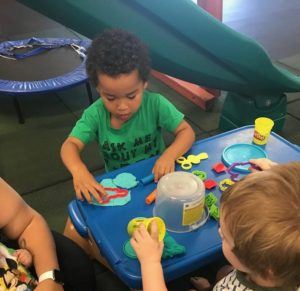Why we Love Playdough
Kids love playdough! But what makes it so special that majority of OTs carry it in their toolbox? Here’s why playdoh is an OT must have and how you can use it like us to fosters new skills, like hand strength, bilateral coordination, fine motor, visual motor, and serves as a sensory tool.

Bilateral coordination or how your child uses their hands together carrying out one movement in unison (symmetrical use) or using one hand to complete a skilled action and the other as a helper or stabilizing (asymmetrical hand use). Good bilateral skills allow your child to complete tasks like, cutting with scissor, stringing beads, tying shoes, or buttoning their shirt. Here are some activities to target bilateral coordination:
- Rolling ball or snakes between both hands or using their hands and the table
- Cutting with scissors
- Making playdough
- Flattening or pounding playdough to make “pancakes”
- Making “pizza dough” by stretching and flattening playdough with both hands
- Practice cutting “food” with a fork and knife
Hand strength is crucial for your child to carry out self-care tasks, such as managing snaps on their pants, opening and closing water bottles, swinging on monkey bars, and keeping up while writing at school. Here are ways to use playdough to focus on hand strength:
- Roll playdough into a snake and pinch with index finger and thumb
- Complete big squeezes in each hand for whole hand strength
- Use cookie cutters to push into play
- Use playdough presses
- Hide small items in playdough and have your child pinch around and “rescue” the lost items
Sound fine motor skills will help your child gain more independence, whether it is by holding their pencil correctly, managing buttons, engaging zippers, or staying in the line while coloring, tracing or forming letters. Playdough will help you target these skills without your child knowing they are doing any work.
- Roll small balls with the tips of their index finger and thumb to increase motor control
- Create a pinch pot, by making a small bowl using their index finger and thumb
- Increased the use of their skilled side of their hand (their index finger and thumb) by placing a small ball of playdough under their ring and pinky finger
- Make a mound of playdough and place a spaghetti noodle in it, and have your child place beads on the noodle
- Flatten playdough then draw shapes, letters, numbers, or designs using a pencil; the resistance from the playdough will help your child remember the motor pattern
- Use playdough scissor to teach your child how to cut along the line
- Create characters, animal, or foods and have your child copy them (snowman, dog, pizza, etc.)
Finally, playdough is a great first sensory experience working on tolerating tactile input or for those kids who require more sensory input throughout their day.
- Let your child soak in all the tactile and proprioception input by smooshing, pounding, and squishing playdough into new shapes
- Make your own playdough and add in Kool-Aid or essential oils to add another sensory component
- If your child is hesitant with new textures or getting their hands dirty, playdough is a great place to start because it is not super sticky where it will stick to your hands.
I hope you enjoyed these ideas of how OTs use playdough to make kids more independent. When in doubt get creative and have fun, and you will surely target some of these skills on your way.
For more information, visit http://www.abcpediatrictherapy.com
Resources:
https://www.ot-mom-learning-activities.com/playdough-activities.html
Pictures from Google Images
Developmental Checklist
Is your child meeting their developmental milestones?
 Skip to content
Skip to content